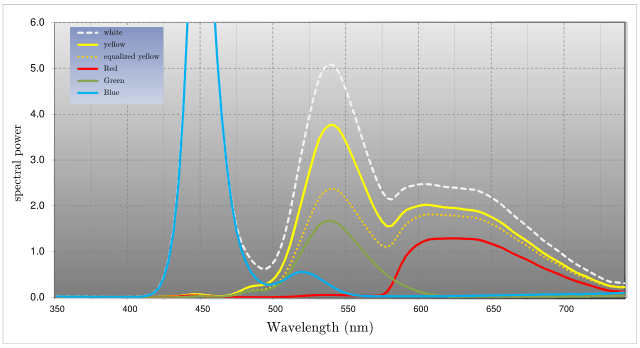Quattron
Quattron is the brand name of an LCD color display technology produced by Sharp Electronics. In addition to the standard RGB (Red Green and Blue) color subpixels, the technology utilizes a yellow fourth color subpixel (RGBY) which Sharp claims increases the range of displayable colors,[1][2] and which may mimic more closely the way the brain processes color information.[3][4] The screen is a form of multi-primary color display, other forms of which have been developed in parallel to Sharp's version.[5][6]
The technology is used in Sharp's Aquos LCD TV product line, particularly in models with screens 40 inches across and larger.[7] The technology, distinct from the product line, has been advertised featuring George Takei as the spokesperson in the debut commercial, in which he uses his catchphrase "Oh My".[8] Another commercial had Takei advertising the 3-D model with the Minions from the 2010 movie "Despicable Me".[9]
Criticism
According to an analysis published in MaximumPC Magazine by Raymond Soneira, president of DisplayMate Technologies, a video calibration equipment producer, Sharp's Quattron technology does not have the ability to show more colors than a standard RGB set. He argues that, due to industry-standard color spaces used by content providers, there is no existing source material that contains the fourth color channel. He further states that any "extra" colors displayed must simply be created in the television itself through video processing, resulting in exaggerated, less accurate color.[10]
Analysis of Quattron
Color researchers at Queen Mary University of London investigated the Quattron technology and found that although Quattron does have 4 physical color sub-pixels it does not have a fourth primary in the backlight to drive it (yellow is approximately 575 nm). Quattron has a yellow sub-pixel but the manufacturer has not made any provision to produce the yellow light needed to pass through it. On that basis they conclude that it serves no useful function.[11]
The lack of a fourth primary is clearly shown by a spectrogram where the red primary is given separately from the green primary. Yellow may be seen to be simply the sum of red and green. A yellow push may also be observed when yellow is compared with the red and green primaries. The spectral power of yellow is approximately twice that of red and green. Yellow colors will therefore appear more prominently on a Quattron display than red or green colors, but this is because the manufacturer has 'pushed' yellow to a higher luminance rather than having improved the color to more closely approximate a natural yellow (such as the yellow of a sunflower), which has a flat spectral power distribution from lime-green to deep red wavelengths. Green dominates the Quattron yellow and this is confirmed perceptually by color matching.[11] The human visual system is particularly sensitive to yellow, and as a result of the lack of a yellow primary (or a yellow boost to either red or green) there will be difficulty in discriminating between green, red and yellow. The reproduction of a yellow image will as a result always be perceived as slightly green or slightly red (or orange) but never a pure natural yellow.

See also
- Color depth
- Gamut
- Trichromacy, scientific description of the RGB model for human vision
- Tetrachromacy, a different biological system than trichromacy, possibly found in some people
- Opponent process, a color theory which considers yellow a primary color in addition to the classic RGB color model.[3]
- PenTile (RGB reproduction via RGBG, RGBW etc.)
References
- ↑ "Sharp Promises Quattron TV Will Wow" CNET Asia, March 23, 2010
- ↑ "Sharp Quattron LC-46LE820M" review by Ty Pendlebury, 16 July 2010, CNET Australia
- ↑ 3.0 3.1 Jay Garrett (2010-03-10). "Sharp Aquos Quattron TV Brings in Yellow Fourth Pixel – RGBY". GadgetyNews.com. Retrieved 2010-04-13.
- ↑ Wakabayashi, Daisuke (26 January 2010). "Sharp Expands Its TV Color Palette". The Wall Street Journal.
- ↑ parallel LCD design from Genoa Color Technologies website
- ↑ multi-primary color display research from GCT
- ↑ Aquos product information at Sharp website
- ↑ Sharp Press Release: Sharp National Brand Advertising Campaign Adds Color to Dynamic HDTV Landscape – "You Have To See It, To See It"
- ↑ platteTV (2010). "Sharp AQUOS Quattron™ 3D TV - George Takei and The Minions". Sharp Corporation. Retrieved 27 January 2012.
- ↑ Dr. Raymond Soneira (July 2010). "Maybe Sharp Should've Consulted Mr. Spock Instead". Maximum PC magazine. p. 51. Retrieved 19 August 2010.
- ↑ 11.0 11.1 Thomas Bangert (19 February 2014). "Appendix C: An Analysis of Quattron". Queen Mary University of London. p. 87. Retrieved 19 February 2014.
External links
- Aquos LCD TV (Sharp website)
- Sharp LC46LE821E Review – Technical assessment of Quattron TV by David Mackenzie at HDTVtest
| |||||||||||||||||||||||||||||||||||||||||||||||||||||||||||||||
| ||||||||||||||||||||||||||||||||||||||||||||||||||||||||||||||||
